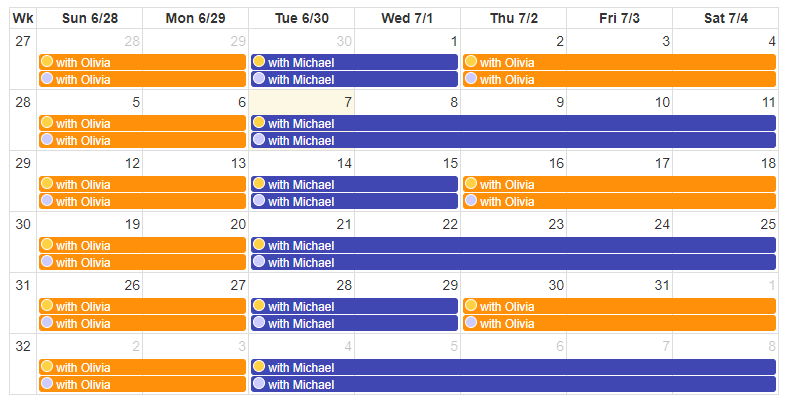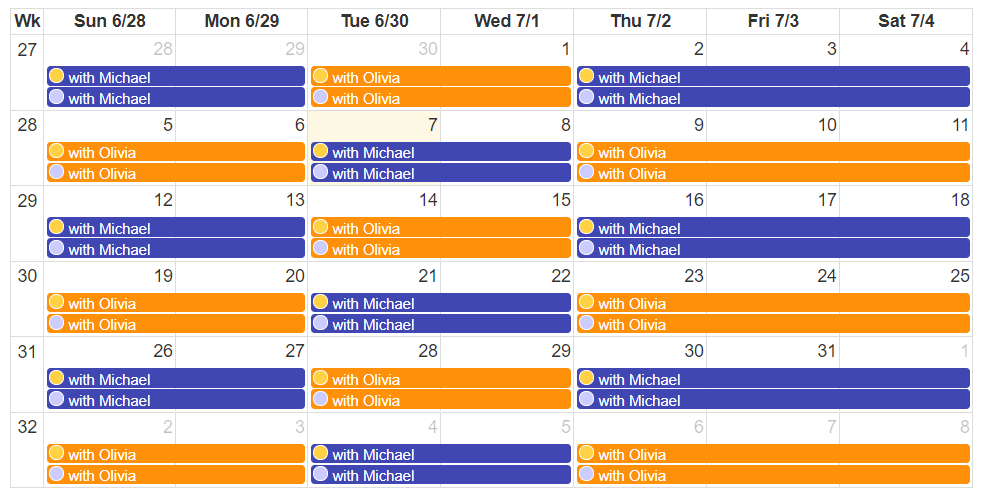Did you know that 50% of children in America will see their parents divorce during their lifetime? So if you are going through a divorce, your kids are in good company and there is plenty of support available for them.
Getting a child custody schedule in place is incredibly important for everyone involved. This means that both you and your ex can plan your lives accordingly. It also ensures that your children understand when they are going to see each parent.
However, a lot of things can affect a child’s custody schedule and your child’s age is one important factor to consider. Want to know more about planning child custody for different age groups? Then you’re in the right place!
Read on to find out everything you need to know about planning proper care to suit your child’s age.
Common Types of Child Custody
If you and your ex have kids, you will come to some sort of custody arrangement during your divorce.
This may be something that you agree on in the terms of your divorce. If you can’t come to an agreement then a judge will decide for you in family court.
Physical custody determines where a child lives and how much time they spend with each parent.
Joint physical custody is the most common type of custody arrangement in the USA today. This means that your children will still be able to see both of their parents.
Sole physical custody means that your children will live with whichever parent has custody. In this setup, the other parent has visitation rights. Visitation rights let you see your child although they do not live with you.
You can also arrange visitation rights for extended family members, such as grandparents. Visitation rights ensure that both parents can still see their child safely.
Legal custody determines who has control of parental decisions regarding education and upbringing. You can share legal custody of your kids even if you don’t share physical custody.
Deciding a Time-Split in Joint Custody
If you decide on joint custody this does not automatically mean that you share a 50/50 custody schedule with your ex. There are lots of ways that you can organize joint custody. These tend to come down to practicality.
A 50/50 schedule involves your child going between homes at regular intervals. This means you both get an equal share of time with them.
They might spend one week with you and one week with your ex, for example. Or they may move between your homes every few days if you live close together.
A 60/40 schedule or 70/30 schedule tends to accommodate one parent’s working schedule more. In these schedules, your child will stay at one home for most of the week. Then they will spend a weekend or an extended weekend with their other parent.
If you don’t like the idea of missing out on weekends with your kids, the 2-2-5-5 arrangement may be for you. This essentially works out as a 50/50 split but means that you both get quality time with your kids. This setup involves:
- Two days with one parent
- Two days with the other parent
- Five days with one parent
- Five days with the other parent
Then you repeat this cycle. This means that you never have to go more than five days without seeing your children.
If you have an intensive working schedule then an 80/20 split could work best for your kids. This means they will be with one parent for two weeks and then enjoy an extended weekend with the other. While one parent gets less time with their kids, this at least means that you can plan properly for this time.
Putting Together a Child Custody Schedule
When putting together a child custody schedule there are plenty of things you need to consider. This includes:
- The amount of time each parent wants to spend with a child
- Your working schedules
- What your child wants and needs
- Your child’s educational and extracurricular schedule
- Your living situations and where your child wants to live
A successful custody schedule will meet the needs of everyone involved and (most importantly) will put the child first. This might take a little time to work out so try to be patient.
Depending on your relationship with your ex, you may want to get support from a lawyer or mediator. They can help you and your ex to communicate effectively. This is especially helpful during a time that will be emotional for everyone involved.
Why Is Age Important for Child Custody Arrangements?
It is also important to think about your child’s age while putting together a child custody arrangement. This is mainly because they will need different types of stability at different ages.
For example, when they are in school, they need to live locally. That way they won’t get tired out moving between households during the school week.
Their age might also affect the type of support and schedule that you and your ex need as well. For example, a parent to an infant will need more support than a parent to a teenager. This is because the practical demands of looking after an infant are greater.
With this in mind, let’s take a closer look at the best custody arrangements for children depending on their age. Of course, it is important to keep other child custody considerations in mind when looking at this.
The Best Custody Arrangement for Infants (Ages 0 to 12 Months)
Managing custody with an infant can be particularly tricky. This is an incredibly important bonding time for both babies and their parents. Because of this, a baby shouldn’t be away from either parent for longer than a few days.
On top of this, you also have to manage an infant’s schedule. Disturbing this too much or too often can make it very difficult for a baby to settle. So finding a compromise is key.
Because of this, it is a good idea for an infant to live with one parent. This means that they will sleep in one house for the first 12 months or so of their lives. Then they should have frequent daytime visits from their other parent.
This may depend a lot on both of your working schedules. It might require to you rearrange your maternity and paternity leave.
As your baby becomes more settled, you can start thinking about overnight stays with their other parent. Babies all develop at different speeds. So the age that this happens at might vary depending on your baby.
This custody arrangement can still happen in a joint custody arrangement. In that case, you and your ex need to agree to revisit the custody schedule as your baby develops and becomes more settled.
The Best Custody Arrangement for Toddlers (Ages 1 to 3 Years)
Toddlers are a lot more adaptable than babies, which means that overnight stays are easier during these years. That said, between one and three your child is undergoing important emotional development.
This means that they are becoming a lot more aware of their surroundings and emotions. They may start to experience fear, empathy, embarrassment, and guilt. During this time it is important that they have security and stability from both of their parents.
Having a consistent schedule throughout toddlerhood is vital because of this. For example, knowing when they are next going to see each parent is extremely important even if you don’t have a fixed schedule. You should avoid your child going for long, unplanned spells without seeing one parent.
You also need to communicate carefully with your children about any changes well in advance. This will add to their sense of security.
As your child gets older, you should never discuss custody arrangements in front of them. That way they won’t feel caught between two different households.
It is also a good idea to always drop your child off rather than picking them up from the other parent’s house. This means that it won’t feel like one parent is interrupting their child’s quality time with another. This also gives each parent time to say goodbye and emotionally prepare their child for drop-off.
The Best Custody Arrangement for Children (Ages 4 to 11 Years)
As your child gets older their schedule will get much busier. This means that you have a lot more organization on your hands.
While it benefits the child to see both parents, it is also important that they can enjoy a normal childhood life. This might involve:
- Going on school trips
- Attending extracurricular clubs
- Going to birthday parties or for play dates
On the plus side, however, you will find that your child becomes more flexible as they get older. In fact, it will probably become harder for you to be away from them than vice versa. This can be very difficult but is a great sign of healthy development in your kids.
If you and your ex live locally, managing a more complex custody schedule is easier. In contrast, if one of you is doing long-distance parenting, this can become more difficult. After all, your children will need to live in one place to attend school.
In that case, it makes more sense for your child to live with one parent during term time. Then they can visit their other parent for long weekends and during the holidays.
If you are doing this, make sure that you still have plenty of contact with your child. Thankfully, there are plenty of great ways to keep in touch now. You can text, call, and FaceTime your kids to maintain regular contact with them easily.
As your children get older, they will understand more about why they don’t live with both of their parents. This can be a tricky transition but it will also make explaining your arrangements easier.
It is important to talk about this in a positive, unified, and productive way. Over time, this understanding will create an important foundation of comfort and stability.
The Best Custody Arrangement for Teenagers (Ages 12 to 17)
During their teenage years, your child will gain a lot more independence and freedom. In most cases, teenagers will continue with the same custody arrangements that they had in childhood. However, this isn’t always the case.
In some states, a child can legally decide which parent they want to live with from the age of 14. This can have a serious effect on your custody arrangements depending on your relationship with your child.
If they do try to start a conversation about moving in with one parent, it is important to handle this carefully. This can be very painful so won’t be easy to do.
To show your child that you are taking things seriously, you may want to bring in a mediator. That way you have support and can avoid saying anything that you might regret.
You should discuss this with your ex away from your child. Ideally, try to present a unified front that puts your child’s best interests first.
Even outside of custody arrangements, it is important that you and your ex communicate about the type of support you give your child. During these years they will need plenty of wisdom and support so make sure you’re both there to give it, no matter where they live.
Get Help Organizing Your Schedule Today
Organizing your child custody schedule should be one of the first things you think about when going through a divorce. This will create stability and support for everyone involved. So what are you waiting for?
For more help staying on top of your child custody schedule, check out the 2Houses app. This is a great way to improve communication and make child custody as easy as possible.








